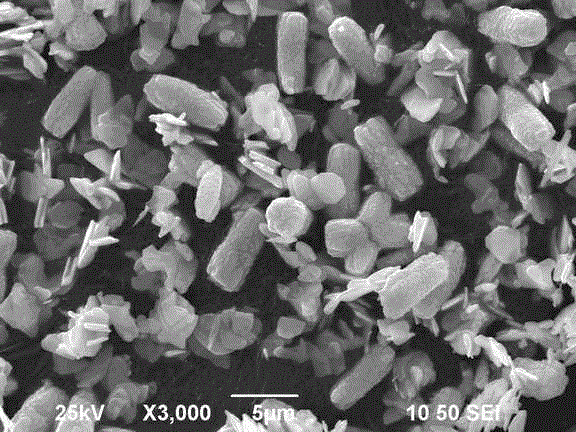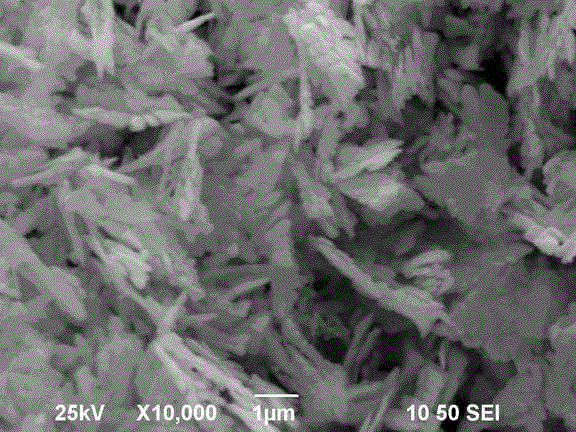Biomimetic synthesis method of bismuth vanadate visible-light-driven photocatalyst with different microtopographies
A biomimetic synthesis technology of bismuth vanadate with morphology, applied in vanadium compounds, chemical instruments and methods, physical/chemical process catalysts, etc., can solve the problems of no photoresponse and low utilization rate of sunlight, and achieve simple and fast operation, High visible photocatalytic activity and controllable product morphology
- Summary
- Abstract
- Description
- Claims
- Application Information
AI Technical Summary
Problems solved by technology
Method used
Image
Examples
Embodiment 1
[0017] Weigh 0.25g of gelatin and dissolve it in 50mL of dilute nitric acid solution with a molar concentration of 1mol / L, wait for the gelatin to dissolve completely, add 1mmol Bi(NO 3 ) 3 ·5H 2O solid, after stirring for 1 h, add 1 mmol NH 4 VO 3 Powder, after stirring for another 30 minutes, adjust the pH of the solution to 1 with ammonia water, then stir for 40 minutes, transfer the precursor solution to a 80mL hydrothermal reactor and react at 180°C for 24 hours. After the reaction, take out the reactor and cool it to room temperature. Centrifuge the yellow precipitate generated by the reaction, wash it repeatedly with deionized water and absolute ethanol, and then put it in a vacuum oven and dry it at 60°C for 12 hours to obtain disc-shaped and columnar bismuth vanadate visible photocatalyst 1, and its scanning electron microscope image See figure 1 .
Embodiment 2
[0019] Weigh 0.25g of gelatin and dissolve it in 50mL of dilute nitric acid solution with a molar concentration of 1mol / L, wait for the gelatin to dissolve completely, add 1mmol Bi(NO 3 ) 3 ·5H 2 O solid, after stirring for 1 h, add 1 mmol NH 4 VO 3 After stirring for another 30 minutes, the pH of the solution was adjusted to 4 with ammonia water, and then after stirring for 40 minutes, the precursor solution was transferred to a 80mL hydrothermal reactor and reacted at 180°C for 24 hours. After the reaction, the reactor was taken out and cooled to room temperature. Centrifuge the yellow precipitate generated by the reaction, wash it repeatedly with deionized water and absolute ethanol, and then put it in a vacuum drying oven at 60 ° C for 12 hours to obtain a maple leaf-shaped bismuth vanadate visible photocatalyst 2. The scanning electron microscope picture is shown in figure 2 .
Embodiment 3
[0021] Weigh 0.25g of gelatin and dissolve it in 50mL of dilute nitric acid solution with a molar concentration of 1mol / L, wait for the gelatin to dissolve completely, add 1mmol Bi(NO 3 ) 3 ·5H 2 O solid, after stirring for 1 h, add 1 mmol NH 4 VO 3 Powder, after stirring for another 30 minutes, adjust the pH of the solution to 7 with ammonia water, then stir for 40 minutes, transfer the precursor solution to a 80mL hydrothermal reactor and react at 180°C for 24 hours. After the reaction, take out the reactor and cool it to room temperature. Centrifuge the yellow precipitate generated by the reaction, wash it repeatedly with deionized water and absolute ethanol, and then put it in a vacuum drying oven at 60°C for 12 hours to obtain the flaky bismuth vanadate visible photocatalyst 3. The scanning electron microscope picture is shown in image 3 .
PUM
 Login to View More
Login to View More Abstract
Description
Claims
Application Information
 Login to View More
Login to View More - R&D
- Intellectual Property
- Life Sciences
- Materials
- Tech Scout
- Unparalleled Data Quality
- Higher Quality Content
- 60% Fewer Hallucinations
Browse by: Latest US Patents, China's latest patents, Technical Efficacy Thesaurus, Application Domain, Technology Topic, Popular Technical Reports.
© 2025 PatSnap. All rights reserved.Legal|Privacy policy|Modern Slavery Act Transparency Statement|Sitemap|About US| Contact US: help@patsnap.com



